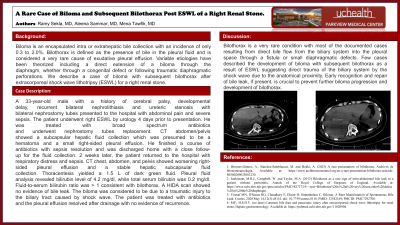Monday Poster Session
Category: Biliary/Pancreas
P1891 - A Rare Case of Biloma and Subsequent Bilothorax Post Extracorporeal Shock Wave Lithotripsy of a Right Renal Stone
Monday, October 28, 2024
10:30 AM - 4:00 PM ET
Location: Exhibit Hall E

Has Audio
- RS
Ramy Sekla, MD
Parkview Medical Center
Pueblo, CO
Presenting Author(s)
Award: Presidential Poster Award
Ramy Sekla, MD1, Aleena Sammar, MD2, Mena Tawfik, MD2
1Parkview Medical Center, Pueblo, CO; 2Parkview Health Center, Pueblo, CO
Introduction: Biloma is an encapsulated intra or extrahepatic bile collection with an incidence of only 0.3 to 2.0%. Bilothorax is defined as the presence of bile in the pleural fluid and is considered a very rare cause of exudative pleural effusion. Variable etiologies have been theorized including a direct extension of a biloma through the diaphragm, whether through a congenital defect or following traumatic diaphragmatic perforations. We describe a case of biloma with subsequent bilothorax after extracorporeal shock wave lithotripsy (ESWL) for a right renal stone.
Case Description/Methods: A 33-year-old male with a history of cerebral palsy, developmental delay, recurrent bilateral nephrolithiasis and ureteric stenosis with bilateral nephrostomy tubes presented to the hospital with abdominal pain and severe sepsis. The patient underwent right ESWL by urology 4 days prior to presentation. He was treated with broad spectrum antibiotics and underwent nephrostomy tubes replacement. CT abdomen/pelvis showed a subcapsular hepatic fluid collection which was presumed to be a hematoma and a small right-sided pleural effusion. He finished a course of antibiotics with sepsis resolution and was discharged home with a close follow-up for the fluid collection. 2 weeks later, the patient returned to the hospital with respiratory distress and sepsis. CT chest, abdomen, and pelvis showed worsening right-sided pleural effusion and a stable hepatic subcapsular fluid collection. Thoracentesis yielded a 1.5 L of dark green fluid. Pleural fluid analysis revealed bilirubin level of 4.2 mg/dl, while total serum bilirubin was 0.2 mg/dl. Fluid-to-serum bilirubin ratio was > 1 consistent with bilothorax. A HIDA scan showed no evidence of bile leak. The biloma was considered to be due to a traumatic injury to the biliary tract caused by shock wave. The patient was treated with antibiotics and the pleural effusion resolved after drainage with no evidence of recurrence.
Discussion: Bilothorax is a very rare condition with most of the documented cases resulting from direct bile flow from the biliary system into the pleural space through a fistula or small diaphragmatic defects. Few cases described the development of biloma with subsequent bilothorax as a result of ESWL suggesting direct trauma of the biliary system by the shock wave due to the anatomical proximity. Early recognition and repair of bile leak, if present, is crucial to prevent further biloma progression and development of bilothorax.
Disclosures:
Ramy Sekla, MD1, Aleena Sammar, MD2, Mena Tawfik, MD2. P1891 - A Rare Case of Biloma and Subsequent Bilothorax Post Extracorporeal Shock Wave Lithotripsy of a Right Renal Stone, ACG 2024 Annual Scientific Meeting Abstracts. Philadelphia, PA: American College of Gastroenterology.
Ramy Sekla, MD1, Aleena Sammar, MD2, Mena Tawfik, MD2
1Parkview Medical Center, Pueblo, CO; 2Parkview Health Center, Pueblo, CO
Introduction: Biloma is an encapsulated intra or extrahepatic bile collection with an incidence of only 0.3 to 2.0%. Bilothorax is defined as the presence of bile in the pleural fluid and is considered a very rare cause of exudative pleural effusion. Variable etiologies have been theorized including a direct extension of a biloma through the diaphragm, whether through a congenital defect or following traumatic diaphragmatic perforations. We describe a case of biloma with subsequent bilothorax after extracorporeal shock wave lithotripsy (ESWL) for a right renal stone.
Case Description/Methods: A 33-year-old male with a history of cerebral palsy, developmental delay, recurrent bilateral nephrolithiasis and ureteric stenosis with bilateral nephrostomy tubes presented to the hospital with abdominal pain and severe sepsis. The patient underwent right ESWL by urology 4 days prior to presentation. He was treated with broad spectrum antibiotics and underwent nephrostomy tubes replacement. CT abdomen/pelvis showed a subcapsular hepatic fluid collection which was presumed to be a hematoma and a small right-sided pleural effusion. He finished a course of antibiotics with sepsis resolution and was discharged home with a close follow-up for the fluid collection. 2 weeks later, the patient returned to the hospital with respiratory distress and sepsis. CT chest, abdomen, and pelvis showed worsening right-sided pleural effusion and a stable hepatic subcapsular fluid collection. Thoracentesis yielded a 1.5 L of dark green fluid. Pleural fluid analysis revealed bilirubin level of 4.2 mg/dl, while total serum bilirubin was 0.2 mg/dl. Fluid-to-serum bilirubin ratio was > 1 consistent with bilothorax. A HIDA scan showed no evidence of bile leak. The biloma was considered to be due to a traumatic injury to the biliary tract caused by shock wave. The patient was treated with antibiotics and the pleural effusion resolved after drainage with no evidence of recurrence.
Discussion: Bilothorax is a very rare condition with most of the documented cases resulting from direct bile flow from the biliary system into the pleural space through a fistula or small diaphragmatic defects. Few cases described the development of biloma with subsequent bilothorax as a result of ESWL suggesting direct trauma of the biliary system by the shock wave due to the anatomical proximity. Early recognition and repair of bile leak, if present, is crucial to prevent further biloma progression and development of bilothorax.
Disclosures:
Ramy Sekla indicated no relevant financial relationships.
Aleena Sammar indicated no relevant financial relationships.
Mena Tawfik indicated no relevant financial relationships.
Ramy Sekla, MD1, Aleena Sammar, MD2, Mena Tawfik, MD2. P1891 - A Rare Case of Biloma and Subsequent Bilothorax Post Extracorporeal Shock Wave Lithotripsy of a Right Renal Stone, ACG 2024 Annual Scientific Meeting Abstracts. Philadelphia, PA: American College of Gastroenterology.

